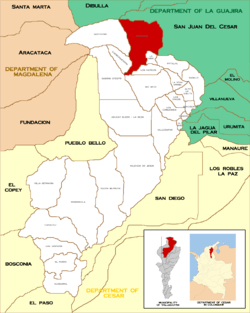Atanquez
Atanquez or San Sebastian is a Colombian town and corregimiento of Valledupar in the Department of Cesar. Atanquez is located on the Sierra Nevada de Santa Marta mountain range at approximately 2,000 m over sea level. Atanquez is known for being predominantly inhabited by the indigenous ethnic group Kankuamos among others and mestizo groups.
Atanquez | |
|---|---|
 Location in the municipality of Valledupar. | |
| Country | Colombia |
| Department | Cesar |
| Municipality | Valledupar |
| Founded | Pre-Columbian |
| Officially established | 1781 |
| Government | |
| • Type | Corregimiento |
| • Corregidor | Ricardo Romero |
| Time zone | UTC-5 |
| Website | www.atanquez.com |
History
Atanquez was an indigenous settlement founded according to oral tradition by a Mama (spiritual leader) named Tukaka.[1] In the mid-18th century the Spanish had already colonized the plains surrounding the Sierra Nevada de Santa Marta mountain range and decided to also colonize the mountains and re-found the indigenous settlements. These indigenous villages were Atanquez, Maraocaso and El Rosario which grew in population due to the displacement caused during the period of Spanish conquest of the Chimila and Guanebucanes in the lower and surrounding areas of the Sierra Nevada de Santa Marta mountains in the 16th century.[2]
The Kogui named these the "Wiwa", while the Arhuaco called them "Arzario". Former African slaves also established in Atanquez and formed the "Palenque of Atanquez". The Spanish sent Capuchin and Dominican friars to "civilize" the indigenous and named it San Sebastian.[3] According to an order of the Royal Audience of Santa Fe de Bogota by a Sub-delegate Judge of Land named Don Agustín de la Sierra in 1781. The corregimiento of Atanquez was created by Municipal Accord of Valledupar 02 on January 4, 1906 and ordered by then Mayor of Valledupar, Moisés Martínez. Atanquez also became part of the indigenous Kankuamo Resguardo created by Resolution 012 of April 10, 2003 as established by the Colombian Institute of Agrarian Reform (INCORA).[1]
Colombian armed conflict
Between 1986 and 2003 the Colombian armed conflict affected the region of Atanquez intensively with 197 Kankuamos murdered by paramilitary and guerrilla groups. The region was influenced by the paramilitary group United Self-Defense Forces of Colombia (AUC), and two guerrillas; the Revolutionary Armed Forces of Colombia (FARC) and the National Liberation Army (ELN).[4] These groups flourished in the region due to the marijuana bonanza of the 1970s and later the use of their traditional Coca plants to produce cocaine and the introduction of amapola plantations.[5]
Economy
The economy of Atanquez is based on agriculture and the production of indigenous art crafts. The main products are panela, liquor from maize and sugar cane, fique, production of medicinal plants, local fruits and vegetables, Cacao and coffee which is commercialize in Valledupar.[6]
Notes
- "Atanquez: history" (in Spanish). Archived from the original on 2008-03-27. Retrieved 2008-04-24.
- Gutierrez Hinojosa 2000, p. 125
- Gutierrez Hinojosa 2000, p. 127
- "Plazamayor.net: Guerrilla y paramilitares han asesinado este año a 44 indígenas kankuamos" (in Spanish). Archived from the original on 2011-07-24. Retrieved 2008-04-24.
- (in Spanish) Universidad del Rosario: Pasado y Presente del Contrabando en La Guajira Aproximaciones al Fenomeno de ilegalidad en la Region
- Gutierrez Hinojosa 2000, p. 126
References
- Gutierrez Hinojosa, Tomas Dario (2000), Valledupar Musica de una Historia, Bogota: Editorial Grijalbo LTDA, ISBN 958-639-175-2
External links
- (in Spanish) Atanquez official website